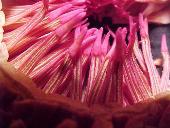 |
|
|
Our more efficient method of emasculating flowers developed in 1998 soon became obsolete in the 1999 season. Again Rich Sacher triggered a whole new area to explore when he discovered that he could remove the whole stamen assembly from the Victoria flower in one piece. We came to call this group of flower parts the Ring.
The Ring includes the upper part of the carpellary appendages, the paracarpels, the stamens, the stamenoids and the inner petals. See "Victoria Flower Anatomy".
Careful removal of the Ring from the first night flower guarantees no accidental self pollination and does not damage the stigma in any way. We were impressed, promptly tried it and adopted the technique.
Several other things we were trying and tracking, crossing Victoria with Euryale and second night pollinations, led us to the next discovery. One morning we actually had a Euryale flower open above the water, our first opportunity of the season to try the cross to Victoria. Though we had a second morning (between the first and second night) flower, we had not emasculated it the first night, planning to self it the second. We wondered if the Ring method used at this time would work.
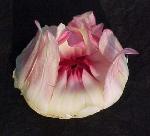
|
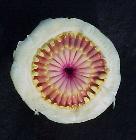 |
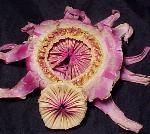 |
|
|
|
|
In this Ring and many others we subsequently checked, no pollen had as yet developed. As long as the Ring was removed completely intact, even the second morning, there was no chance of accidental pollination. But what if an anther was nicked and dribbled into the stigma? Would it continue to develop? The answer was yes. But . . .
WHAT IF the pollen would ripen within the Ring, even removed from the flower? It not only did ripen by early evening but also proved fully viable in crosses. See picture at top of page. We crudely approximated conditions within the flower to experiment with this, leaving Rings outside in the shade, wrapped in tracing paper sitting in a wire strainer enfolded in a bed sheet.
Before the Ring Thing we had been limited in making crosses by the fact that we had to self the pollen parent while collecting pollen for the pod parent. Like this:
and to
cruziana emasculated 1st night (pollinated 1st or 2nd night)
Now we were able to make reciprocal crosses like this:
to
2nd night cruziana flower (ring removed 2nd morning) = 'Longwood Hybrid'
AND
cruziana ring pollen (removed 2nd morning)
to
2nd night amazonica flower (ring removed 2nd morning) = 'Adventure'
This effectively doubled the number of crosses we could make with the same number of flowers. It worked consistently, important in that our cruzianas were late starting to bloom and the early ones even then were sterile.
In 1998, we successfully stored ripe anthers in the refrigerator for as many as five days. We wondered if we could store unripened Rings in the frig, take them out and "wake them up". Most successful was placing the Ring under a warm bright light. The pollen beds opened but the pollen was not viable. We were able to store rings already shedding pollen for up to five days with successful pollinations.
Joe Summers at Missouri Botanical Garden also experimented successfully with Ring emasculation and reciprocation. We tried overnighting unripened rings to each other without success. Something during shipping must arrest development of the pollen, perhaps the cold in flight. Shipping developed pollen has been successful.
We must mention that Rings removed from first night flowers do not continue to develop pollen in most cases, only those harvested the second morning. It is however, either the first night or second morning, the easiest and most effective method of emasculation and simple to do.
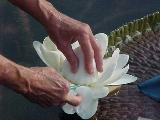
|
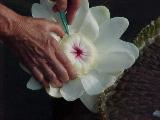
|
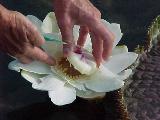
|
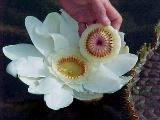
|
|
|
|
|
|
We remove enough inner petals to clearly see the base of the stamenoids. Using a scalpel, long-bladed X-acto knife or surgical scissors, we make a cut into the base of the stamenoids through the carpellary appendages. The angle of the cut is determined by which type of plant is involved. The paracarpels of amazonica and 'Adventure' angle toward the stigma so the angle of the cut must be steep. The paracarpels of cruziana and 'Longwood Hybrid' are rather flat so the cut can be flat. We continue to cut around at the same level, lifting slightly as we go, and out pops the intact Ring.
Enchanted Forest | Can It Happen? | Open The Door!
1999 The Adventure Continues | 2000 A Very Bad Year | 2001 A Banner Year
2002 An Even Better Year | 2003 We Like It Like This | 2004 Trust
2005 Recovery | 2006 Normal? | 2007 Weird | 2008 Year of the Hare
2009 Year of the (White) Tortoise